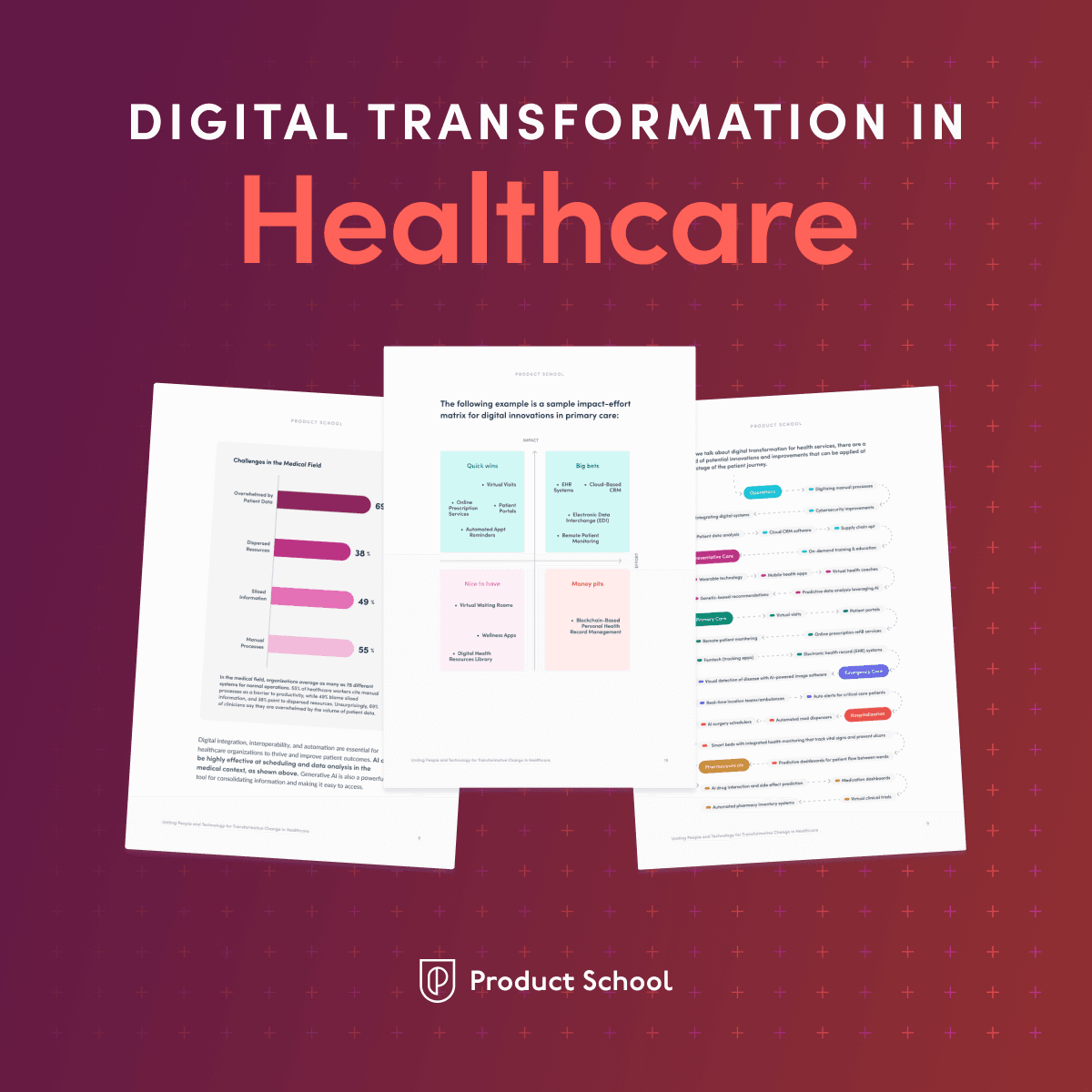Updated: June 12, 2025- 15 min read
While the concept of digital transformation sounds promising, many companies dive in without a clear direction. This is the failing formula. According to a study by McKinsey, 70% of digital transformation efforts fail to achieve their goals. This highlights the need for a practical, structured approach.
That’s where digital transformation frameworks come in handy. This systematic effort provides a roadmap for navigating the complexities of transforming a business bit by bit, with scrutiny and precision.
By adhering to frameworks, businesses can increase their chances of success and avoid common pitfalls. In this guide, we'll explore what digital transformation frameworks are, how they make enterprise digital transformations possible, what makes a good framework, and how to choose or build one tailored to your needs. Let's turn the buzz into real, actionable advice.
Healthcare Industry Report
Dive into the latest research about digital transformation in healthcare in this white paper from Product School. Spark ideas with 6 case studies and over 25 digital solutions from operations to pharmaceuticals to primary care and more.
Download report
What is a Digital Transformation?
Many leaders may assume digital transformation is just about using new technology. Needless to say, it's much more.
This transformation involves a cultural shift within the organization, where innovation, agility, and data-driven decision-making become central to business strategy. It is not merely about digitizing existing processes but about reimagining business models and workflows to harness the full potential of digital technologies.
This includes leveraging product analytics, cloud computing, artificial intelligence, and other digital tools to enhance efficiency, improve product experiences, and create new revenue streams. The goal is not to jump on the bandwagon. It’s to make the business more competitive, resilient, and responsive to changing market demands.
For example, a retail store might switch from only selling products in-store to having full-blown omnichannel commerce. Imagine the type of organizational change needed to make this happen — that’s what digital transformation is trying to solve as well. It’s about rethinking business processes and strategies to take full advantage of digital advancements, making the business more efficient and in tune with a new generation of customers.
What is a Digital Transformation Framework?
A digital transformation framework is a structured approach that guides an organization through the process of integrating digital technologies into every aspect of its operations. Think of it as a roadmap that outlines the steps and strategies needed to successfully transform a business digitally.
A digital transformation strategy framework helps in planning and executing this change effectively. It includes setting clear goals, understanding the current state of the business, identifying the technologies needed, and creating a step-by-step plan to implement these technologies.
There are various digital transformation frameworks, each tailored to different business needs and industries. These frameworks provide a systematic way to handle complex changes, ensuring that every aspect of the transformation is covered, from technology adoption to employee training and customer experience improvements.
Using digital transformation strategy frameworks helps businesses stay focused and organized during their digital journey. They ensure that all parts of the business move together towards common goals. Lastly, they reduce the risk of failure by a margin and increase the chances of a successful transformation.
Why Do Businesses Need a Framework for Digital Transformation?
Businesses need a framework for digital transformation to ensure a structured and effective approach. Here are all the reasons they should consider having a framework as a guiding light.
Structured Approach: A framework provides a clear, organized plan for implementing digital changes. This way all steps are systematically addressed.
Alignment with Business Goals: It helps align digital initiatives with the overall business strategy. It ensures that technology investments support the company's objectives.
Risk Management: Frameworks help identify potential risks and provide strategies to mitigate them, reducing the likelihood of project failures.
Efficiency and Consistency: By following a standardized approach, businesses can streamline processes and ensure consistency across different departments and projects.
Resource Optimization: A framework helps in the efficient allocation and utilization of resources. Having one ensures time, money, and talent are used effectively.
Improved Decision-Making: With a clear digital transformation roadmap, businesses can make informed decisions based on data and insights, rather than guesswork.
Change Management: Change is a cultural and organizational shocker. Frameworks include strategies for managing the shock of culture transformation and helping employees adapt to new ways.
Performance Tracking: They provide mechanisms for monitoring progress and measuring the impact of digital initiatives. This allows businesses to adjust strategies as needed.
Scalability: A well-defined framework can be scaled up or down depending on the size and scope of the digital transformation efforts, making it adaptable to various business needs.
Competitive Advantage: By effectively managing digital transformation, businesses can stay ahead of competitors and respond more quickly to market changes and customer demands.
What Makes a Good Digital Transformation Framework?
A good digital transformation framework is critical. It guides an organization through the complexities of adopting new digital technologies. Plus, it ensures that these changes align with broader business objectives. Here are the key elements that make a robust and effective digital transformation framework:
1. Clear Vision and Objectives
Alignment with Business Goals: The framework should start with a clear vision that aligns with the company's overall strategy and objectives. This ensures that digital initiatives support the broader goals of the organization.
Measurable Outcomes: Establish specific, measurable goals that can track progress and assess the impact of the transformation.
2. Comprehensive Assessment
Current State Analysis: Conduct a thorough assessment of the current digital capabilities and processes. Understand the existing technology stack, workflows, and cultural readiness for change.
Gap Analysis: Identify gaps between the current state and the desired future state. This helps in prioritizing initiatives that will close these gaps effectively.
3. Strategic Roadmap
Phased Implementation: Develop a roadmap that outlines the sequence of initiatives, allowing for a phased approach to transformation. This reduces risk and allows for adjustments based on early learning.
Milestones and Timelines: Set clear milestones and timelines for each phase of the transformation to ensure that the project stays on track.
4. Technology Integration
Scalable and Flexible Solutions: Choose technologies that are scalable and can adapt to future changes. This ensures that the framework remains relevant as the business evolves.
Interoperability: Ensure that new technologies can seamlessly integrate with existing systems and processes to avoid disruptions.
5. Change Management
Stakeholder Engagement: Engage all stakeholders from the outset to gain buy-in and support. This includes executives, managers, and employees who will be affected by the transformation.
Training and Support: Provide adequate training and resources to help employees adapt to new technologies and processes. This minimizes resistance and enhances adoption.
6. Governance and Leadership
Dedicated Leadership: Establish a dedicated leadership team or digital transformation office to oversee the implementation and ensure accountability.
Governance Framework: Create a governance structure that includes policies, standards, and procedures to guide the transformation efforts and maintain control.
7. Data-Driven Decision Making
Analytics and Insights: Utilize data analytics to drive decisions and measure success. This involves tracking key performance indicators (KPIs) and using insights to make informed adjustments.
Continuous Improvement: Implement a feedback loop that allows for continuous monitoring and improvement of processes and technologies.
8. Customer-Centric Approach
Customer Experience: Focus on improving the customer experience as a core objective of the digital transformation. This involves understanding customer needs and leveraging digital tools to enhance service delivery.
Feedback Mechanisms: Establish mechanisms to gather customer feedback and use it to refine and improve digital initiatives.
9. Innovation and Agility
Culture of Innovation: Foster a culture that encourages experimentation and innovation. This allows the organization to stay ahead of technological trends and rapidly respond to market changes.
Agile Methodologies: Adopt agile methodologies that enable quick iterations and adjustments, ensuring that the transformation remains responsive to evolving business needs.
10. Sustainable Practices
Long-Term Perspective: Ensure that the digital transformation framework considers long-term sustainability. This includes planning for future technology advancements and maintaining flexibility to incorporate them.
Environmental and Social Responsibility: Integrate practices that support environmental sustainability and social responsibility, aligning with broader corporate values.
By incorporating these elements, a digital transformation framework can effectively guide an organization through the complexities of digital change, ensuring alignment with business goals, minimizing risks, and achieving sustainable success.
15 Examples of Digital Transformation Frameworks
Enterprise Architecture Frameworks
These frameworks provide a structured and systematic approach to digital transformation, ideal for large organizations. They help design, plan, implement, and govern enterprise-wide changes, ensuring alignment with strategic goals and integration of new technologies.
TOGAF (The Open Group Architecture Framework)
Suitable for large organizations needing a structured approach to digital transformation. TOGAF provides a comprehensive approach to designing, planning, implementing, and governing enterprise information architecture. It is suitable for large organizations that need a structured and systematic approach to digital transformation.MIT Digital Transformation Framework
Ideal for companies wanting a holistic approach that integrates digital advancements across all business aspects. The MIT Digital Transformation Framework focuses on customer experience, operational processes, business models, digital capabilities, and leadership.
Process Improvement and Efficiency Frameworks
Focused on optimizing business processes, these frameworks eliminate waste and enhance quality. They are essential for organizations committed to continuous improvement and operational excellence, enabling streamlined operations and quick responses to market changes.
Lean Six Sigma
Great for organizations focused on continuous improvement and operational excellence. Lean Six Sigma combines lean manufacturing processes with Six Sigma methodologies to improve performance by systematically removing waste.Agile Transformation
Beneficial for organizations needing flexibility and speed in their digital transformation efforts. Agile focuses on iterative development, where requirements and solutions evolve through collaboration.
Customer-Centric Frameworks
Prioritizing customer experience, these frameworks help businesses understand and meet customer needs. They integrate new technologies to improve interactions and satisfaction, making them ideal for companies focused on customer-driven strategies and innovations.
Perfect for businesses aiming to enhance customer interactions and streamline operations. Capgemini’s model emphasizes customer experience, operational processes, and business models, integrating new technologies to drive business innovation.
Accenture Digital Transformation Framework
Emphasizes innovation, customer experience, and operational efficiency. Accenture’s framework focuses on leveraging digital technologies to drive business outcomes, emphasizing innovation, customer experience, and operational efficiency.
Organizational Alignment Frameworks
These frameworks align various organizational elements like strategy, structure, and culture, ensuring cohesive operation. They are crucial for managing change and ensuring all parts of the business work towards common goals, fostering a unified approach to transformation.
Suitable for businesses needing to ensure that all organizational elements are aligned and working towards common goals. The McKinsey 7S Model aligns seven internal elements: strategy, structure, systems, shared values, style, staff, and skills.
Helps organizations identify and develop new digital business opportunities. The Gartner Digital Business Framework helps organizations identify and develop new digital business opportunities by focusing on strategy, leadership, organization, technology, and metrics.
Assesses digital maturity across culture, technology, organization, and insights. Forrester’s model assesses digital maturity across four dimensions: culture, technology, organization, and insights.
Technology and Data-Driven Frameworks
Emphasizing the use of technology and data, these frameworks enhance business performance by measuring digital capabilities and developing strategies. They are suitable for organizations aiming to leverage technology and data analytics for decision-making and competitive advantage.
Measures an organization's ability to harness digital technology. The PwC Digital IQ framework measures an organization's ability to harness and profit from digital technology, assessing leadership, innovation, experience, technology, and culture.
Focuses on strategy, business model, operations, and technology. The Deloitte Digital Transformation Framework focuses on strategy, business model, operations, and technology.
BCG Digital Acceleration Index (DAI)
Measures a company’s digital maturity across multiple dimensions. The BCG Digital Acceleration Index (DAI) measures a company’s digital maturity across multiple dimensions, including strategy, capabilities, and culture.IDC Digital Transformation Framework
Provides a roadmap for digital transformation. IDC’s framework provides a roadmap for digital transformation, focusing on leadership, omnichannel experience, information, operating model, and work source.
Data and Innovation Frameworks
These frameworks focus on using data and innovative technologies to drive transformation. They support data-driven decision-making and process optimization, helping businesses innovate and adapt to the digital landscape. Ideal for organizations seeking agility and growth through data insights.
Emphasizes data-driven decision-making and customer experience. KPMG’s Digital Delta framework emphasizes data-driven decision-making, customer experience, and operational efficiency.
Cognizant Digital Transformation Framework
Focuses on reimagining business models and customer experiences. Cognizant’s framework focuses on reimagining business models, processes, and customer experiences through digital technologies.
How to Create Your Own Digital Transformation Framework
There's no universal solution for digital transformation frameworks; what succeeds for one company might fail for another. Of course, existing digital transformation methodologies can only offer so much.
Creating your own framework can be the right alternative. Yes, it may feel overwhelming, and that's understandable. Digital transformation involves significant changes and investments. Plus, you could be spending your resources elsewhere.
However, building your own framework has its unique advantages. It makes cross-functional teams conscious of all moving parts — they have to think through the process and make mental models that allow them to better understand this undertaking. It’s similar to learning to cook through experimentation, not recipes. There will be trial and error, of course. But you get to understand how different ingredients blend together which offers a deeper understanding of the process at hand.
If you’re set to create your own or make adjustments to existing frameworks, here’s how to engineer the process to suit your business.
Define Your Vision and Objectives
Businesses should begin by clearly defining what digital transformation means for their specific context. This involves setting clear, achievable goals, such as enhancing customer experience, boosting operational efficiency, or launching new digital products. A well-defined vision acts as a guiding star, ensuring that every decision and action aligns with the overarching objectives. This clarity not only helps in aligning the efforts of various teams but also in maintaining focus throughout the transformation journey.
Assess Your Current State
A thorough assessment of current digital capabilities and processes is essential. Businesses need to understand their existing technology landscape, skill sets, and cultural readiness for change. Identifying gaps between the current state and the desired future state allows for the prioritization of efforts and resources. This step helps in pinpointing the areas that require immediate attention and sets a baseline for measuring progress.
Engage Stakeholders Early
Engaging key stakeholders from the outset is crucial for the success of a digital transformation. This includes leadership, IT teams, department heads, and even customers. Their input helps in shaping realistic goals and expectations. Moreover, securing their buy-in ensures that there is support and commitment across the organization, which is vital for overcoming resistance to change and ensuring smooth implementation.
Develop a Roadmap
Creating a detailed roadmap is essential for guiding the digital transformation process. This roadmap should outline the specific steps needed to achieve the set goals, breaking down the transformation into manageable phases.
Setting clear milestones helps in tracking progress and maintaining momentum. The roadmap should also include timelines, assigned responsibilities, and resource allocation to ensure that everyone involved knows their role and the project stays on track.
Focus on Customer Experience
Improving customer experience should be a central focus of any digital transformation strategy. Businesses need to understand their customers' needs, preferences, and pain points. Using this information, they can design digital solutions that enhance the customer journey.
Whether through personalized services, streamlined processes, or innovative products, prioritizing customer experience can drive loyalty and satisfaction, ultimately leading to better business outcomes.
Leverage Data and Analytics
Utilizing data and analytics is critical for informed decision-making. Businesses should collect data on customer behavior, operational performance, and market trends. Analyzing this data helps identify opportunities for improvement and tracks the impact of digital initiatives. Data-driven insights allow businesses to make adjustments to their strategy as needed, ensuring that efforts are aligned with changing market conditions.
Foster a Culture of Innovation
Creating a culture that embraces innovation is vital for sustaining digital transformation. Businesses should encourage experimentation and allow teams to test new ideas without fear of failure. Providing training and resources helps employees develop necessary digital skills. A culture that supports innovation not only drives the transformation forward but also ensures that the organization remains agile and responsive to new opportunities.
Invest in the Right Technology
Choosing the right technologies is crucial for achieving digital transformation goals. This may include cloud computing, artificial intelligence, machine learning, or the Internet of Things (IoT). The selected technology should integrate seamlessly with existing systems and be scalable to accommodate future growth. Investing in the right technology ensures that businesses can efficiently achieve their transformation objectives.
Establish Governance and Leadership
Setting up a governance structure to oversee digital transformation efforts is essential. Businesses should appoint a dedicated team or leader responsible for managing the process. This team should have the authority to make decisions and allocate resources as needed. Effective governance and strong leadership help maintain momentum, ensure accountability, and address any issues that arise during the transformation.
Monitor and Adjust
Regularly monitoring the progress of digital transformation initiatives is critical. Businesses should use key performance indicators (KPIs) to measure success and identify areas for improvement. Being prepared to adjust the strategy based on what is learned ensures that the transformation remains on course. Continuous monitoring and flexibility help businesses adapt to changes and achieve their goals.
By following these steps, businesses can build a customized digital transformation framework tailored to their specific needs and objectives. This personalized approach can be more effective than adopting a generic framework, as it considers the unique challenges and opportunities of the business.
Empower Your Team for Digital Transformation
Digital transformation is as much about people as it is about technology. A successful transformation hinges on the cultural acceptance of new ways of working and continuous employee training.
To support this critical aspect of your transformation journey, consider exploring Product School's corporate training services. We offer tailored programs designed to upskill teams, ensuring they are well-prepared to navigate the complexities of digital transformation. Start building a future-ready team today and unlock the full potential of your digital transformation initiatives.
Product Team Training
Align your Product Teams, upskill from within, and outpace the competition.
Get brochure
Updated: June 12, 2025




